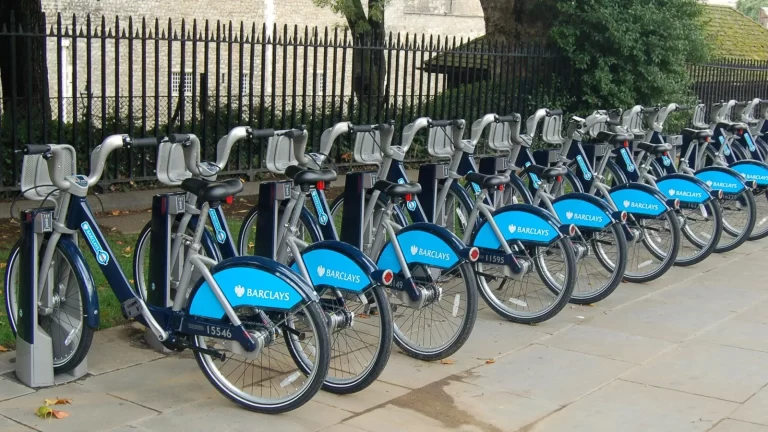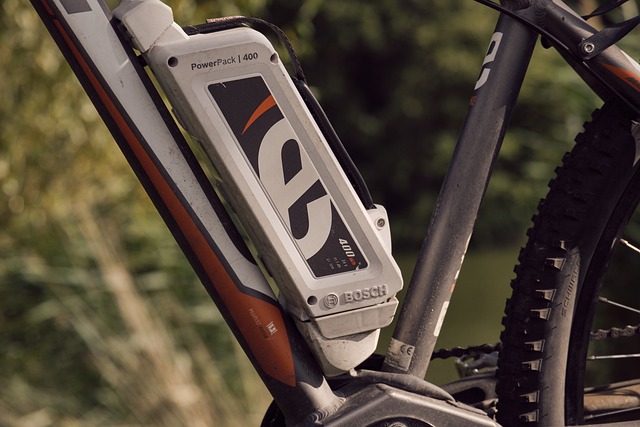Can I Replace the Battery on My Electric Bike?
Electric bikes, or e-bikes, have surged in popularity in recent years. They offer a fun, eco-friendly way to commute, explore your surroundings, and get some exercise without breaking a sweat. But like any electric device, an e-bike’s performance hinges on its battery.
A healthy battery means a smooth ride with ample range. However, as with all batteries, e-bike batteries eventually lose their capacity over time. This can lead to shorter rides and more frequent charging. If you’re noticing a decline in your e-bike’s performance, you might be wondering: Can I replace the battery on my electric bike?
The answer, for most e-bikes, is a resounding yes! This blog post will delve into everything you need to know about replacing your e-bike battery, from understanding the signs that it’s time for a new one to exploring your replacement options and the factors that affect cost. By the end, you’ll be equipped to make informed decisions about keeping your e-bike running strong for years to come.
Key Takeaways
- Removable Power: The good news is that most e-bikes boast removable batteries, making replacement a relatively straightforward process. This allows you to easily swap out a depleted battery for a fresh one and get back on the road quickly.
- Signs It’s Time for a Change: Just like any battery, your e-bike battery’s capacity will naturally decrease over time. This can manifest in a few ways:
- Reduced Range: You might find yourself needing to recharge your battery more frequently to achieve the same distance you used to cover on a single charge.
- Longer Charging Times: A noticeable increase in charging time could indicate the battery is less efficient at holding a charge.
- Frequent Shutdowns: Unexpected shutdowns during your ride can be frustrating and a potential sign of a failing battery.
- Understanding Replacement Costs: The price tag for a replacement e-bike battery can vary depending on a few factors:
- Battery Capacity: Higher capacity batteries that offer a longer range typically cost more.
- Battery Voltage: Higher voltage batteries can deliver more power and might be more expensive.
- Brand: Brand-name batteries might come with a premium price tag, but they’re guaranteed to be compatible with your e-bike model.
- Compatibility is Key: Using a battery that isn’t specifically designed for your e-bike model can be dangerous and lead to malfunctions. Ensure compatibility by checking your e-bike’s manual, consulting the brand’s website, or seeking help from a qualified professional.
- DIY or Pro? Replacing your e-bike battery can often be done at home, especially if your model has a removable battery. However, if you’re unsure about any step in the process, don’t hesitate to consult a qualified e-bike mechanic or service center. They can ensure everything is done correctly and address any questions you might have.
- Rejuvenate Your Ride: A new battery isn’t just about replacing a worn-out component; it’s an investment in enhancing your e-bike experience. With a fresh battery, you can reclaim your range, enjoy improved performance with smoother acceleration and hill climbing, and potentially extend the lifespan of your entire e-bike.
- Beyond Replacement: There’s more to e-bike batteries than just swapping them out. Consider exploring e-bike battery trade-in programs offered by some manufacturers or retailers. Additionally, familiarizing yourself with proper battery care practices, such as avoiding extreme temperatures and using the correct charger, can significantly extend the lifespan of your new battery.
Understanding E-Bike Batteries
The heart of your e-bike’s performance lies in its battery. Just like the gasoline powers a traditional car, the battery acts as the e-bike’s main source of energy. It supplies the electricity that runs the motor, propelling you forward and assisting your pedaling when needed.
There are a few different types of batteries used in e-bikes, but Lithium-ion (Li-ion) batteries are the most common by far. Here’s why they reign supreme:
- High energy density: Lithium-ion batteries pack a powerful punch in a relatively small and lightweight package. This translates to a longer range on a single charge for your e-bike.
- Long lifespan: Compared to other battery types, Lithium-ion batteries boast a longer lifespan, meaning they can go through more charge cycles before needing replacement.
- Lightweight: Lighter weight translates to a lighter overall e-bike, making for a more enjoyable ride.
- Slow discharge: Lithium-ion batteries lose their charge slowly when not in use, so you won’t experience significant power drain if you leave your e-bike unused for a while.
While Lithium-ion reigns supreme, you might encounter a few other battery types on some older e-bikes:
- Lead-acid batteries: These are significantly heavier than Lithium-ion batteries and offer a shorter range. They’re also more susceptible to damage from extreme temperatures.
- Nickel Metal Hydride (NiMH) batteries: These fall somewhere in between Lithium-ion and lead-acid in terms of weight, capacity, and lifespan. However, they aren’t as common as Lithium-ion batteries in today’s e-bikes.
RELATED CONTENT – How Long Does an Ebike Battery Last?
Replacing Your E-Bike Battery: What You Need to Know
Just like any rechargeable battery, your e-bike’s battery will naturally lose some capacity over time. This translates to a decrease in performance, and eventually, the telltale signs will become clear. Here are some key indicators that your trusty e-bike battery might be nearing the end of its lifespan:
- Reduced Range: This is perhaps the most noticeable sign. You might find yourself needing to recharge your battery more frequently to achieve the same distance you used to cover on a single charge.
- Longer Charging Times: If it’s taking noticeably longer to fully charge your e-bike battery, it could be a sign that the battery is less efficient at holding a charge.
- Frequent Shutdowns: Unexpected shutdowns during your ride can be frustrating and even dangerous. While there could be other culprits, a failing battery is a prime suspect. If your e-bike sputters and shuts down more often, it might be time to consider a replacement.
Beyond these key signs, keep an eye out for any unusual behavior:
- Does your battery feel unusually hot after charging or during use? Excessive heat can be a sign of internal damage.
- Are there any visible bulges or deformations in the battery casing? This is a safety hazard and a clear indication that the battery needs to be replaced immediately.
Noticing any of these signs doesn’t necessarily mean your e-bike adventures are over! The good news is that replacing your e-bike battery is often a straightforward process, and it can breathe new life into your beloved electric ride.
RELATED CONTENT – On the Go Charging Strategies for your Ebike While Traveling
RELATED CONTENT – How to Reset Electric Bike Battery
Cost Considerations: Understanding the Price Tag
The cost of replacing your e-bike battery can vary depending on several factors. Here’s a breakdown of the key influences on the price tag:
- Battery Capacity: Measured in ampere-hours (Ah), capacity refers to the amount of energy a battery can store. The higher the Ah rating, the longer the range you can expect on a single charge. So, if you crave longer rides and fewer charging stops, expect to pay more for a higher capacity battery [cost to replace e bike battery with longer range].
- Battery Voltage: E-bike batteries typically range from 24 volts (V) to 48V. In general, higher voltage batteries can deliver more power to the motor, resulting in stronger acceleration and hill-climbing ability. They may also be compatible with higher wattage motors. However, higher voltage batteries often come at a premium price.
- Brand: Just like with any product, brand names can sometimes influence cost. Popular e-bike brands might charge a bit more for their own replacement batteries. That said, these batteries are guaranteed to be compatible with your specific e-bike model and may offer additional features or warranties.
Finding the Right Balance:
While a high-capacity, high-voltage, brand-name battery might sound ideal, it’s important to find a balance that fits your needs and budget. Consider your riding habits:
- Do you prioritize long-range rides or shorter commutes? A higher capacity battery might be worth the investment for longer adventures.
- Do you encounter many hills on your rides? A higher voltage battery might be beneficial for tackling inclines.
Budget-Conscious Options:
If affordability is a top concern, there are some ways to keep the cost down:
- Lower capacity batteries: If your rides are typically shorter, a lower capacity battery might suffice.
- Third-party batteries: While not always recommended, some reputable third-party battery manufacturers offer compatible replacements at a lower cost than brand-name options. Do your research to ensure quality and compatibility before considering this option!
Remember, the cheapest option isn’t always the best in the long run. A lower quality battery might not perform as well or have the same lifespan as a brand-name or high-capacity option. It’s important to weigh the cost against the value and performance you’ll receive.
For a general cost reference, e-bike battery replacements can range anywhere from under $200 for lower capacity options to over $700 for high-capacity, high-voltage batteries from brand-name manufacturers.
RELATED CONTENT – Ultimate Guide to Charging Your Electric Bike: Tips, Tricks & Best Practices
Compatibility: Ensuring a Perfect Fit
When it comes to replacing your e-bike battery, compatibility is key. Using a battery that isn’t specifically designed for your e-bike model can be dangerous and lead to malfunctions. Here’s why compatibility matters:
- Safety First: Batteries are complex electrical components. An incompatible battery might not fit properly in the designated compartment, potentially causing damage to the battery, your e-bike, or even yourself.
- Performance Issues: An incompatible battery might not communicate correctly with your e-bike’s motor controller. This could result in reduced performance, unexpected shutdowns, or even motor damage.
Finding the Perfect Match:
So, how do you ensure you get a battery that works seamlessly with your e-bike? Here are a few tips:
- Consult your e-bike’s manual: The manual should have specific information about the compatible battery model for your e-bike. This is the safest and most reliable way to ensure a perfect fit.
- Check the e-bike brand’s website: Many manufacturers offer replacement batteries specifically designed for their e-bike models directly on their websites [where to buy genuine replacement ebike battery].
- Seek professional help: If you’re unsure about compatibility or have difficulty finding the information you need, consider consulting a qualified e-bike mechanic or service center. They can help you identify the correct replacement battery for your specific e-bike model.
The Temptation of Third-Party Batteries:
While it might be tempting to choose a lower-cost, third-party battery, it’s crucial to exercise caution. While some reputable third-party manufacturers offer compatible batteries, it’s essential to thoroughly research the brand and product before making a purchase.
Here are some red flags to watch out for:
- Vague product descriptions: A lack of detailed specifications or compatibility information should raise a red flag.
- Significantly lower price point: If the price seems too good to be true, it probably is. A very low price might indicate a lower quality battery that could pose safety risks.
Remember, investing in a compatible battery, even if it costs a bit more upfront, is an investment in the safety and longevity of your e-bike.
RELATED CONTENT – Tips for Proper Storage and Charging for your Electric Bike Battery
RELATED CONTENT – Guide to Choosing the Right Electric Bike Battery
Replacing the Battery Yourself: DIY or Seek Help?
The good news is that replacing your e-bike battery can often be done at home! For many e-bikes with removable batteries, the process is relatively straightforward. However, before diving in, it’s crucial to consider your comfort level and technical skills.
Here’s a quick overview of the general steps involved:
- Locate the battery compartment: This will typically be secured on the frame of your e-bike, often with a lock or latching mechanism. Consult your e-bike’s manual for specific instructions on locating and accessing the battery compartment.
- Unlock and remove the old battery: Once you’ve accessed the compartment, follow the manual’s instructions for unlocking and safely removing the old battery.
- Slide in the new battery: Ensure the new battery is properly aligned and securely seated in the compartment.
- Lock the battery compartment: Secure the compartment using the latch or lock mechanism.
A word of caution: While a general overview can be helpful, every e-bike model might have slight variations in the replacement process. Always refer to your e-bike’s manual for detailed, model-specific instructions.
For added peace of mind:
- If you’re unsure about any step in the process, don’t hesitate to consult a qualified e-bike mechanic or service center. They can guide you through the replacement process and ensure everything is done correctly.
Ultimately, the decision of whether to replace the battery yourself or seek professional help depends on your comfort level and technical expertise. If you’re unsure or feel more comfortable having a professional handle it, don’t hesitate to reach out to a qualified e-bike service provider.
Here’s a helpful resource that you can use as a general reference, but remember, it might not be specific to your e-bike model:
Brand-Specific Options: Finding the Perfect Fit
Many e-bike manufacturers offer replacement batteries specifically designed for their own e-bike models. These batteries are guaranteed to be compatible with your bike and might even come with additional features or warranties. Here’s a quick look at how some popular e-bike brands handle replacement batteries:
- Trek: Trek offers a variety of replacement e-bike batteries for their Powerfly and Verve+ e-bike lines directly on their website. These batteries are designed to seamlessly integrate with your Trek e-bike and come with a warranty. You can find them by searching “replace Trek electric bike battery” on their website.
- Specialized: Specialized also offers replacement batteries for their Turbo series e-bikes through their authorized dealers. Visit your local Specialized dealer or browse their website for options.
- Giant: Giant provides replacement e-bike batteries for their E-bike models through their authorized Giant retailers. Contact your local Giant retailer or check their website for details on replacing your Giant e-bike battery.
- Rad Power Bikes: Rad Power Bikes sells replacement batteries compatible with their Rad e-bikes directly on their website. They offer various capacities to suit your range needs. Search “replace Rad Power Bikes battery” on their website for details.
- Yamaha: Yamaha offers replacement batteries for their Yamaha-powered e-bikes through authorized Yamaha dealers. Consult your local Yamaha dealer or their website for information on replacing your Yamaha e-bike battery.
Beyond these brands, many other e-bike manufacturers offer replacement batteries. It’s always best to check the brand’s website or contact an authorized dealer for the most up-to-date information and to ensure compatibility with your specific e-bike model.
RELATED CONTENT – Electric Bikes with Long Battery Life
RELATED CONTENT – Top 5 Electric Bike Batteries
Benefits of Replacing Your E-Bike Battery
A new lease on life for your trusty e-bike? Replacing your battery can be a game-changer, offering a multitude of benefits that will reignite your love for electric riding. Here’s how a fresh battery can breathe new life into your e-bike adventures:
- Reclaim Your Range: As we discussed earlier, battery capacity naturally diminishes over time. This translates to a shorter range on a single charge. Replacing your battery with a new one of the same or even higher capacity can significantly improve your range. Imagine venturing further on those scenic rides or tackling longer commutes without worrying about running out of juice!
- Boost Your Performance: A new battery isn’t just about going further; it can also enhance your overall riding experience. A healthy battery delivers power to the motor more efficiently, resulting in improved acceleration, smoother hill climbing, and a more responsive ride overall [does a new ebike battery improve performance]. Whether you’re conquering inclines or zipping through city streets, a new battery can make your e-bike feel more responsive and enjoyable.
- Extend the Lifespan of Your E-Bike: Think of your e-bike battery as the heart of your electric steed. By replacing a failing battery, you’re essentially investing in the longevity of your entire e-bike. A healthy battery reduces strain on the motor and other electrical components, potentially extending the lifespan of your e-bike for years to come.
In short, replacing your e-bike battery is more than just a repair; it’s an investment in enhancing your riding experience and extending the life of your beloved e-bike. So, if you’ve noticed a decline in performance or range, consider a battery replacement and rediscover the joy of electric riding!
Additional Considerations: Beyond the Replacement
Replacing your e-bike battery is a great way to revitalize your rides, but there are a few other things to consider:
- E-Bike Battery Trade-In Programs: Looking to be eco-conscious and potentially offset the cost of a new battery? Some e-bike manufacturers and retailers are starting to offer battery trade-in programs [e bike battery trade in program]. These programs allow you to return your old battery when you purchase a new one, and you might even receive a discount on the replacement. It’s always a good idea to check with your e-bike brand or local retailer to see if they offer a trade-in program.
- Proper Battery Care for a Longer Life: Just like any rechargeable battery, your e-bike battery will perform best with proper care. Here are some simple tips to maximize the lifespan of your new battery:
- Avoid extreme temperatures: Store your battery in a cool, dry place and avoid exposing it to direct sunlight or freezing temperatures.
- Don’t fully deplete the battery: It’s best to recharge your battery when it reaches around 20% capacity. Letting it completely drain can reduce its lifespan.
- Use the correct charger: Always use the charger that came with your e-bike or a compatible replacement from a reputable brand.
- Responsible Disposal of Old Batteries: E-bike batteries contain hazardous materials and shouldn’t be thrown away in regular trash. Many electronics retailers and recycling centers offer safe e-bike battery disposal options. Research your local regulations and find a responsible way to dispose of your old battery once you’ve replaced it.
By following these additional considerations, you can not only ensure a smooth transition with your new battery but also contribute to a more sustainable future for e-bikes!
FAQs
Absolutely! With proper care, you can maximize the lifespan and performance of your e-bike battery. Here are some key practices to keep in mind:
Temperature matters: Avoid storing your battery in extreme temperatures, both hot and cold. Aim for a cool, dry place when not in use.
Partial charges are preferable: Instead of letting your battery drain completely before recharging, aim to top it up when it reaches around 20% capacity. This reduces stress on the battery and improves its longevity.
Use the right charger: Always stick to the charger that came with your e-bike or a compatible replacement from a reputable brand.
The cost of a replacement e-bike battery can vary depending on several factors, as we discussed earlier in the cost considerations section. Here’s a quick recap:
Battery capacity: Higher capacity batteries that offer a longer range typically cost more.
Battery voltage: Higher voltage batteries can deliver more power and might be more expensive.
Brand: Brand-name batteries might come with a premium price tag, but they’re guaranteed to be compatible with your e-bike model.
In general, replacement e-bike batteries can range anywhere from under $200 for lower capacity options to over $700 for high-capacity, high-voltage batteries from brand-name manufacturers.
There are a few options for purchasing a replacement e-bike battery:
E-bike brand websites: Many e-bike manufacturers sell replacement batteries specifically designed for their own models directly on their websites. This is often the safest option to ensure compatibility.
Authorized e-bike retailers: These retailers might carry replacement batteries for various e-bike brands.
Online retailers: Several online retailers offer replacement e-bike batteries. Be cautious when buying online and ensure thorough research on compatibility and brand reputation before making a purchase.
Conclusion
So, there you have it! We’ve explored everything you need to know about replacing your e-bike battery, from understanding the signs it’s time for a new one to navigating the factors that affect cost and compatibility. With a new battery on board, you can reclaim your range, boost your performance, and extend the lifespan of your trusty e-bike.
Replacing your e-bike battery is an investment in keeping your electric adventures rolling smoothly. Remember, proper care and responsible disposal practices go a long way in maximizing the life of your new battery and minimizing environmental impact.
Ready to get back on the road with renewed power? Armed with this knowledge, you can confidently explore your options and find the perfect replacement battery for your e-bike.
We encourage you to share your experiences in the comments below!
Have you replaced your e-bike battery? What factors influenced your decision? Do you have any questions or tips to share with fellow e-bike riders? Let’s keep the conversation charged and help each other get the most out of our electric journeys!
External Sources
E-Bike Battery Care:
- https://ebikes.org/maintenance/complete-e-bike-battery-care-guide/ This comprehensive guide from eBikes.org covers all aspects of e-bike battery care, including storage, charging, and maximizing lifespan.
E-Bike Battery Trade-In Programs:
- https://shopbikesupply.com/collections/turbo-batteries While not all manufacturers have dedicated webpages for trade-in programs, some, like Specialized, might mention it on their replacement battery pages. You can check the Specialized website or contact your local authorized Specialized dealer for details on their specific program.
- https://www.trekbikes.com/us/en_US/equipment/e-bike-equipment/e-bike-batteries-parts/c/E532/ Similar to Specialized, Trek may offer trade-in programs. Check their website or contact your local Trek retailer for details.
- https://www.radpowerbikes.com/products/rad-battery-pack-2021 Rad Power Bikes offers replacement batteries directly on their website. While they might not have an official trade-in program listed, you can always contact them to inquire about potential options.
E-Bike Battery Replacement:
- https://www.bosch-ebike.com/us/products/batteries This webpage provides information on the ebike batteries from Bosch.
Kristina Grant is not just an enthusiast but a true authority on electric bikes. Nestled in the coastal beauty of Virginia, Kristina has found the perfect backdrop for her passion for electric biking. As a dedicated wife and homeschooling mom, her life revolves around family, faith, and the thrill of adventure.
Originally hailing from Ohio, Kristina's journey with electric bikes began as a curiosity and quickly evolved into a deep expertise. Her blog is a testament to her love for electric biking, combining her fascination for eco-friendly transportation with her coastal lifestyle.
When she's not cruising the beach on her electric bike, you'll find Kristina indulging in her other loves: long walks along the shore, getting lost in a good book, and cherishing moments with her loved ones. With a heart as big as her love for animals, especially cats, Kristina brings a unique perspective to the electric bike world, grounded in her strong faith in God and her dedication to a sustainable lifestyle.
Through her blog, Kristina shares her extensive knowledge of electric bikes, offering valuable insights, tips, and recommendations to fellow enthusiasts. Whether you're a seasoned rider or a newcomer to the electric bike scene, Kristina's blog is your go-to source for all things electric biking, fueled by her passion, expertise, and the scenic beauty of coastal Virginia.







